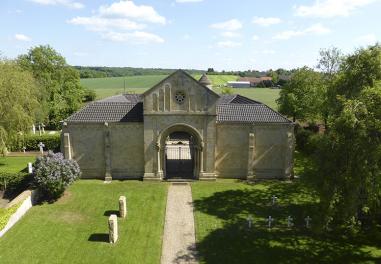Christian Berger
Director of tourism for the Nord-Pas-de-Calais region, Christian Berger promotes remembrance sites in the region on a national and international level. A land of battles and fighting in the past, the Nord-Pas-de-Calais region today is a land of history, heritage and culture.
How did remembrance tourism develop in Nord-Pas-de-Calais and what is its impact today?
Sites that witnessed the fighting in the First World War began to be visited immediately after the conflict with the discovery of the former battlefields of Artois and Flanders and the devastated towns. Then, the State undertook to develop large remembrance sites such as the national cemetery of Notre-Dame de Lorette, the largest French military cemetery which became a major national remembrance site in 2014.
The second world war also generated a large number of remembrance sites: Dunkirk, La Coupole near Saint-Omer or the Wellington Quarry in Arras. The involvement of the Allies in both world wars gave a very strong international reputation to several towns and villages in the area: Cambrai and Dunkirk for the British, Vimy for the Canadians, Fromelles for the Australians, Le Quesnoy for New Zealanders... Every year, thousands of foreign visitors come to explore the remembrance sites 1914-18 in the North of France and pay tribute to the memory of their country's soldiers.
Remembrance tourism thus contributes to the economy of the region and the benefits are significant: in the hotel industry in 2014 overnight stays for foreign tourists were up 12% and they spent some €56.8 million between July 2013 and June 2014.
What is the remembrance tourism offer like in this region?
Four thematic regional circuits - the Ypres front line in Cambrai, the war of movement and the German occupation, the coastline, the base for the allies and the reconstruction of devastated territories - invite visitors to discover the most significant sites in order to understand the history of the Great War and that of the various warring nations. We decided to enhance the appeal of the region by explaining the historical and heritage interest of remembrance sites.
The creation of local 1914-18 heritage interpretation trails is now underpinning this approach. Our tourist offer takes a contemporary form around a message of peace. "Paix, Frieden, Peace" is the signature of the regional remembrance trails dynamic. This unifying attitude helped transcend the purely military dimension of the conflict opening it up to a shared international memory.
The civic opening out to the world is undoubtedly an approach that will perpetuate visits to remembrance sites in the region far beyond the Great War centenary commemorations. The strengthened cooperation with "Atout France" and the ministries of Defence and Tourism as set down in an operational agreement also seems to us to be the means of ensuring sites maintain their appeal after the commemorations.
How are you preparing to receive tourists for the upcoming commemorations of the centenary of the Great War?
With all French partners whose territories were crossed by the Western Front in the Great War, the Nord-Pas-de-Calais region has been working since 2014 on putting together a shared communication strategy around one common destination
"The Western Front 1914-1918".
This dynamic has strong support from the State - the economy and defence ministries - as well as the First World War centenary mission and "Atout France".
In this context, a "Northern France Battlefields Partner"
network was set up bringing together accommodation and catering providers, tourist offices and transportation companies. In all some 300 professionals have been made aware of the history and heritage of the Great War in order to meet the expectations of different visitors and advise them. It is our image, the image of a committed and welcoming regional territory that is at stake.
Read more
Articles of the review
-
The file

Remembrance tourism, a national issue
Remembrance tourism is a major issue for the State and especially for the Ministry of Defence: a civic and educational element crucial to pass the memorial heritage on to the younger generations, a cultural and tourism issue also in order to preserve historical testimony and develop the territories....Read more -
The event

The Remembrance Tourism Meetings 2015
Read more -
The figure
Remembering the deported
Established at one end of the Île de la Cité in Paris, behind the apse of Notre-Dame Cathedral, the Deportation Memorial has benefited from an enormous programme of restoration. Its new content is to be inaugurated in April 2016, on the occasion of the National Day of Remembrance of the Deportation....Read more

